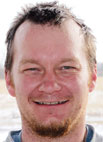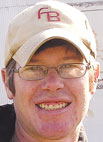 Kenneth Gossard’s Texas County sheep wasn’t something that he thought would stick around, after moving to Princeton, N.J. “I am a manager on a dairy, sheep and hog farm there, working with the dairy and consulting for possible dairy goats they are looking at.” But, even though he lives in New Jersey the majority of the time, he still manages his flock near Willow Springs, Mo. “Basically I come back a couple times of year, specifically for the sheep,” Kenneth said. He raises the sheep for the wool and as freezer lambs.
Kenneth Gossard’s Texas County sheep wasn’t something that he thought would stick around, after moving to Princeton, N.J. “I am a manager on a dairy, sheep and hog farm there, working with the dairy and consulting for possible dairy goats they are looking at.” But, even though he lives in New Jersey the majority of the time, he still manages his flock near Willow Springs, Mo. “Basically I come back a couple times of year, specifically for the sheep,” Kenneth said. He raises the sheep for the wool and as freezer lambs.
“The high demand in the wool market encouraged us to get more ewes,” Kenneth’s dad, Rob, said. “There were incentives in place and it could be shipped down to Texas for high prices. We raised sheep because of the high quality of the wool and the fact they are proven to do well and grow on grass,” Rob added.
According to Kenneth, they do well here in the Ozarks. “They’re a hearty breed of sheep and can handle the cold better than the heat, but the heat doesn’t really bother them too much. They are insulated against the heat and cold,” he added, “kind of like your drink cup can be!”
Meat Lambs
Lamb chops, roast and leg of lamb are all popular meat cuts. “The meat has a very unique flavor. It’s unlike beef or pork, having a lower fat content and proving to be healthier than other meats,” he said. “It’s kind of like deer meat for those familiar with that, however there is no gamy or wild taste.”
The Wool
Kenneth makes a trip to Missouri in January to shear the ewes before lambing. Then they are free from the extra weight and wool and they go inside to lamb around March. “When I sheer them, there is six to seven inches of wool and their udder is actually hid. When they are sheared, the young lambs have better access to their milk source and start out strong and grow well,” he added.
Kenneth does all the shearing one time a year. Then he processes the wool and ships it east to sell. “The market is better out east so my process is worth more there,” he said.
He shears the animals and prepares the wool himself. “Many people like the fact that the wool is from a basic natural farm. The sheep are grass-fed, sheared by hand and then the wool is processed by one person. They like to be able to trace the yarn all the way back to the beginning and have it all come from one source,” he explained.
After the ewes are sheared, the wool is washed or soaked in hot water and detergent. “Then it’s allowed to air dry and it is ‘carded’. Not to get into the local bars, but it’s to align the fibers, like if you were brushing your hair,” Kenneth chuckled.
Once all the fibers are going in the same direction it’s transferred to a drum carder and then goes to the spinning wheel. “It is usually classified by long fiber wool or short fiber. It is very unusual to find the two mixed together from one ewe,” Kenneth added. During the shearing process, Kenneth keeps the wool from each ewe separate in its own bag.
“I don’t take pre-orders. If I chose to dye the wool, I always have buyers. Many times I process it and sell it natural and they can chose to dye the yarn to create whatever project they want. Naturally the wool is an ivory color – well the color of clean, fresh sheep,” he added.







